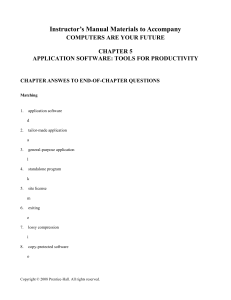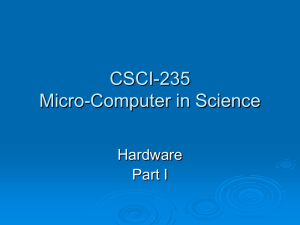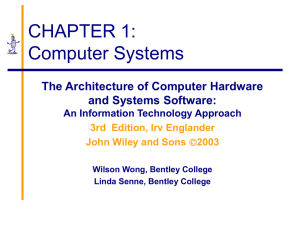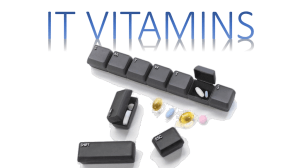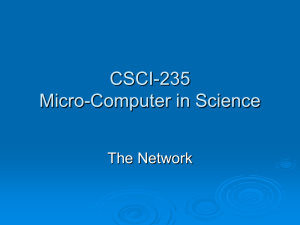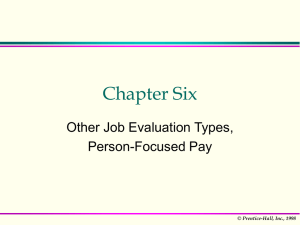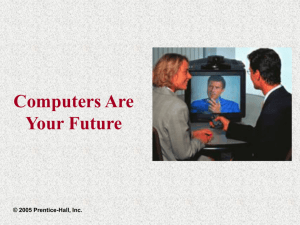2006 Prentice-Hall, Inc.
advertisement
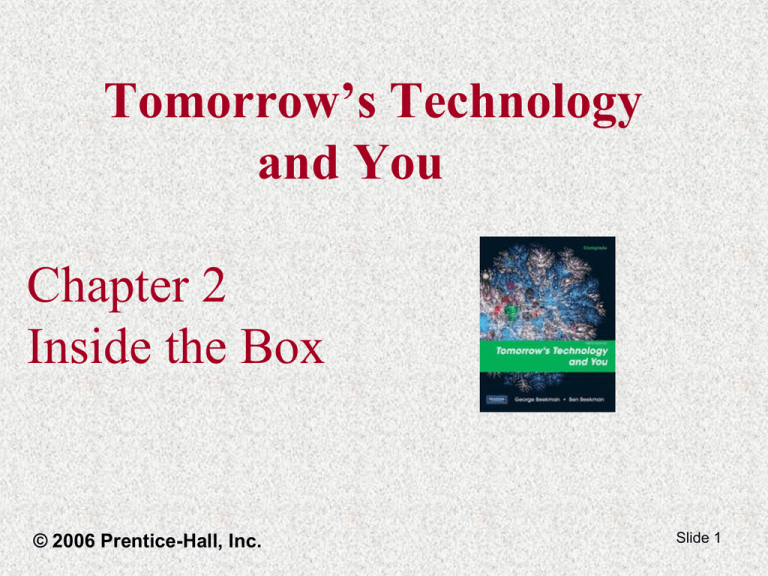
Tomorrow’s Technology and You Chapter 2 Inside the Box © 2006 Prentice-Hall, Inc. Slide 1 Chapter 2 Objectives What can we learn from Apple? How can we minimize the negative effect of computers on the environment? What is likely in the future of computer CPU and memory and what might be the ramifications? (Note that we are not covering the Hardware basics portion of this chapter – use it as a resource if you need explanations of basics in work on later chapters) © 2006 Prentice-Hall, Inc. Slide 2 What can we learn from Apple? (pages 37-38) First successful ‘PC’ in late 70’s “Apple 2” what was the secret of success? “Macintosh” in 1984 what was special about it? why did it not prevail over the IBM/Microsoft PC? What is Apple doing today? What can we learn from Steve Jobs’ experience? © 2006 Prentice-Hall, Inc. Slide 3 Chapter 2 Objectives What can we learn from Apple? How can we minimize the negative effect of computers on the environment? What is likely in the future of computer CPU and memory and what might be the ramifications? (Note that we are not covering the Hardware basics portion of this chapter – use it as a resource if you need explanations of basics in work on later chapters) © 2006 Prentice-Hall, Inc. Slide 4 Environmental Impact (pp 48-49) What are the problems? What can we do? Recycle waste products - such as? Send bits, not paper – how? Recycle old computers Reuse / Dispose - what will you do? Why? Security issues and Solutions What are the problems? What do you plan to do? Use laptop, not desktop – or is this good advice? What else can we do? © 2006 Prentice-Hall, Inc. Slide 5 Chapter 2 Objectives What can we learn from Apple? How can we minimize the negative effect of computers on the environment? What is likely in the future of computer CPU and memory and what might be the ramifications? (Note that we are not covering the Hardware basics portion of this chapter – use it as a resource if you need explanations of basics in work on later chapters) © 2006 Prentice-Hall, Inc. Slide 6 The Future of CPU & RAM (pp 58-59) How ‘big’ are computers today? How is ‘size’ of CPU/RAM measured? Why does it matter? What is typical for home/business? Will the recent pace of advance continue? How? (What technologies have promise?) So what? Are they likely to be more reliable also? What might be the result? Are they likely to be more ubiquitous? Where are they likely to appear where they are not used today? What are the potential benefits and risks? Slide 7 Chapter 2 In-Class Activity Go to the ‘In-class discussion - Week 2’ Forum, and use the Reply to post as follows: Change header to your first name (or nickname) In the body of the post, tell us the following about your home computer, (or the one in front of you, if you prefer) Size of RAM Speed of CPU Your analysis – is this too small? OK? Bigger than needed? – and why do you say this? © 2006 Prentice-Hall, Inc. Slide 8

